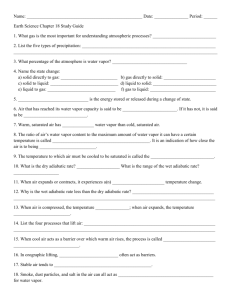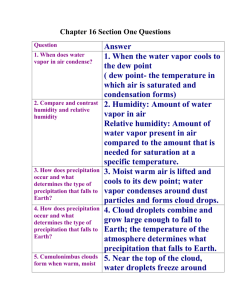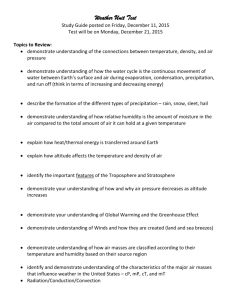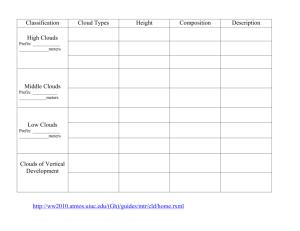Cloud Precipitation
advertisement
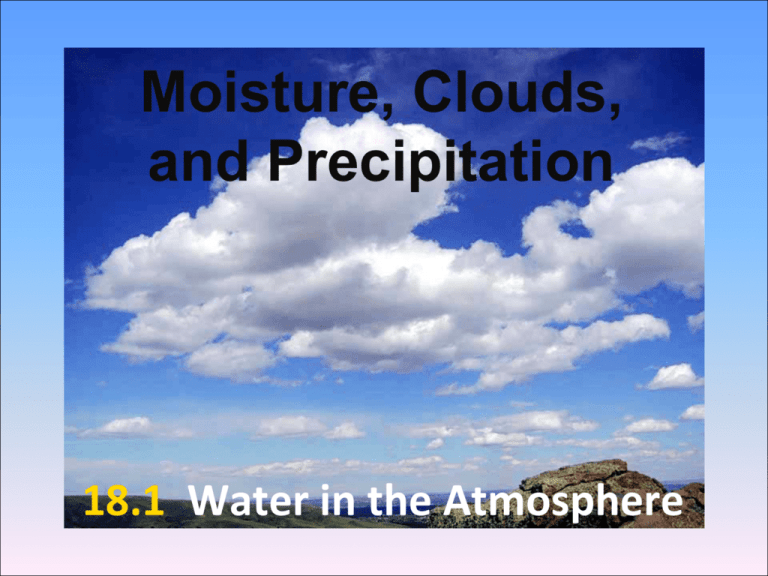
Moisture, Clouds, and Precipitation 18.1 Water in the Atmosphere Water in the Atmosphere Precipitation is any form of water that falls from a cloud. When it comes to understanding atmospheric processes, water vapor is the most important gas in the atmosphere. Solid to Liquid Water in the Atmosphere • The process of changing state, such as melting ice, requires that energy be transferred in the form of heat. The energy absorbed or released during a change in state is called LATENT HEAT.. Liquid to Gas • Evaporation is the process of changing a liquid to a gas. • Condensation is the process where a gas, like water vapor, changes to a liquid, like water. Changes of State Water in the Atmosphere Humidity is a general term for the amount of water vapor in air. Saturation • Air is saturated when it contains the maximum quantity of water vapor that it can hold at any given temperature and pressure. • When saturated, warm air holds more water vapor than cold saturated air. Water in the Atmosphere Relative Humidity • Relative humidity is a ratio of the air’s actual water-vapor content compared with the amount of water vapor air can hold at that temperature and pressure. • To summarize, when the water-vapor content of air remains constant, lowering air temperature causes an increase in relative humidity, and raising air temperature causes a decrease in relative humidity. Relative Humidity Actual Water Amount Saturation Water Amount Water in the Atmosphere Dew Point • Dew point is the temperature to which a parcel of air would need to be cooled to reach saturation. Relative Humidity Varies with Temperature Water in the Atmosphere Measuring Humidity • A hygrometer is an instrument to measure relative humidity. • A psychrometer is a hygrometer with dry- and wetbulb thermometers. Evaporation of water from the wet bulb makes air temperature appear lower than the dry bulb’s measurement. The two temperatures are compared to determine the relative humidity. Sling Psychrometer A dewdrop can exalt us like the music of the sun… - Yes, Close to the Edge. 18.2 Cloud Formation Air Compression and Expansion Adiabatic (iso-heat) Temperature Changes • When air is allowed to expand, it cools, and when it is compressed, it warms. Expansion and Cooling • Dry adiabatic rate is the rate of cooling or heating that applies only to unsaturated air. • Wet adiabatic rate is the rate of adiabatic temperature change in saturated air. 18.2 Cloud Formation Expansion and Cooling • Rising air cools 10 °C with every 1,000 meters of height in the dry adiabatic zone (unsaturated air). • Rising air cools 5 °C with every 1,000 meters of height in the wet adiabatic zone (saturated air). • Cloud formation begins as you enter the wet adiabatic zone (saturated air). Cloud Formation: Temperature Cloud Formation Four mechanisms that can cause air to rise are: 1. orographic lifting 2. frontal wedging 3. convergence 4. localized convective lifting. Cloud Formation Orographic Lifting ( oro = mountain) • Orographic lifting occurs when mountains act as barriers to the flow of air, forcing the air to ascend. • The air cools adiabatically; clouds and precipitation may result. Orographic Lifting Cloud Formation Frontal Wedging • A front is the boundary between two adjoining air masses having contrasting characteristics. Frontal Wedging Convergence • Convergence is when air flows together and rises. Localized Convective Lifting • Localized convective lifting occurs where unequal surface heating causes pockets of air to rise because of their buoyancy. Cloud Formation For any form of condensation to occur, the air must be saturated. Types of Surfaces • Generally, there must be a surface for water vapor to condense on. • Condensation nuclei are tiny bits of particulate matter that serve as surfaces on which water vapor condenses when condensation occurs in the air. Metal is colder to the touch than the surrounding air! Cloud Types Clouds are classified on the basis of their form and height. • Cirrus (cirrus = curl of hair) are clouds that are high, white, and thin. Cloud Types • Cumulus (cumulus = a pile) are clouds that consist of rounded individual cloud masses. Cloud Types • Stratus (stratus = a layer) are clouds best described as sheets or layers that cover much or all of the sky. They are high in altitude. Cloud Types • Nimbus (nimbus = cloud) clouds that contain rain: nimbostratus; cumulonimbus (pictured). Cloud Types: Summary Cloud Summary (Short; Avg.; Crown) Height Cumulus Stratus Thunder/Rain 6000 m Cirrocumulus Cirrostratus Cumulonimbus 4000 m Altocumulus Altostratus 2000 m Stratocumulus Stratus Cumulonimbus Environment: Inversion Layers Cloud Precipitation Fog is defined as a cloud with its base at or very near the ground. Fog Caused by Cooling • As the air cools, it becomes denser and drains into low areas such as river valleys, where thick fog accumulations may occur. Fog Caused by Evaporation • When cool air moves over warm water, enough moisture may evaporate from the water surface to produce saturation. Cloud Precipitation The type of precipitation that reaches Earth’s surface depends on the temperature profile in the lower few kilometers of the atmosphere. Rain • The term rain means drops of water that fall from a cloud and have a diameter of at least 0.5 mm. Cloud Precipitation Snow • At very low temperatures (when the moisture content of air is low) light fluffy snow made up of individual six-sided ice crystals forms. Cloud Precipitation Other types of precipitation: • Sleet is the fall of clear-totranslucent ice. • Hail is produced in cumulonimbus clouds. • Hailstones begin as small ice pellets that grow by collecting supercooled water droplets as they fall through a cloud. Largest Recorded Hailstone
